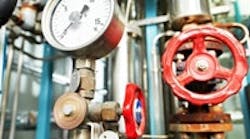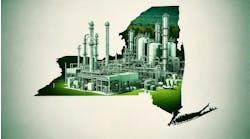Operating and maintaining a reliable steam system is vital to chemical processing plants and can have significant cost impact on a plant's annual budget. Typical profit drainers in operating and maintaining a steam system include excessive fuel cost, inefficient steam generation, less-than-optimal steam utilization and poor condensate recovery. Ensuring adequate supply of steam often results in excessive capacity usage, expensive fuel choices or condensate draining to grade, leading to compromised efficiency levels and higher steam cost. Because steam system dependency is unavoidable, addressing those three issues is crucial to minimizing steam costs.
[pullquote]
Optimize steam generation capacity. A chemical processing plant in upstate New York operated all six of its boilers to meet its frequently surging steam demand. After analyzing the normal and peak steam demands of its several processing buildings, engineers concluded that one boiler could be stopped during the day with the help of a steam demand controller and another during the night shift. Successful results from multiple trials stopping one boiler during the night shift paved the way for operating personnel to stop the second boiler during the day.
The necessity to review steam demand may arise when a plant expands its capacity or adds another steam-dependent processing unit. In such cases, a new steam demand analysis combining the existing and additional steam demands may help optimize new boiler capacity to meet the increased demand. It even may be possible to avoid a new boiler addition.
Optimize fuel choice. Steam costs highly depend on the cost of fuel fired in the boiler. Typically, fuel prices increase from low-grade fuels such as bio-mass, to medium-grade fuels like coal, to higher-grade petroleum fuels such as oil and LPG. Natural gas prices usually fall between medium to higher-grade fuel costs. Most chemical processing plants in the United States use natural gas to fuel their boilers. A few plants use coal-fired boilers to meet steam demand, while very few use bio-mass as their fuel and those that do must modify their boilers accordingly.
The project cost of installing boilers also increases as the fuel choice moves from gaseous fuels to liquids, solids and bio-mass fuels. In addition, steam generation cost significantly depends upon the plant's location and the availability, and market prices, of fuels. Predicting fuel supply price changes long term is very difficult, so, one way to optimize steam cost is to retrofit or modify the boilers' burners or combustion systems to fire multiple fuels.
Some plants generate rejects or unusable and unmarketable byproduct streams. Retrofitting boiler burners to fire those waste streams as fuel could help reduce steam costs. Hence, it's worth investing in multiple fuel-fired boiler systems in all medium- and large-sized chemical processing plants.
Improve condensate return systems. Processes critically dependent on steam heating must have reliable condensate removal. Condensate backing up inside the heat transfer equipment (due to stalling, excessive back-pressure in the return piping or water hammer problems) should be drained to grade to avoid interruptions in steam heating. Properly sizing the condensate return piping and providing appropriate flash separation from steam condensate is an essential requirement of a condensate return system. However, properly sized return piping could become under-sized when more condensate sources are connected to it, or excessive flash steam generation occurs in the return piping due to operational changes of the steam-heated equipment.
Because the immediate option to maintain steam heating is to waste the condensate by draining it to grade, personnel should alert management to the monetary losses associated with condensate drain. If not addressed, steam cost will remain high and profits will drain silently.
Utilize waste heat for steam generation. Most plants have waste gas incinerators operating continuously to burn off toxic and other waste gases from the process. Because these waste gas stream flows occur occasionally and mostly in small quantities, fuel always is firing the incinerator beds to maintain the incineration temperature. In some plants, this fuel firing almost equals the consumption of a small- or medium-sized boiler. Hence, it's worth exploring waste-heat steam generation from incinerators or heaters that exhaust the flue gases to stacks at temperatures above 400°F.
Next month's column will highlight more on controlling steam system energy costs.
VEN V. VENKATESAN is Chemical Processing's Energy Columnist. You can e-mail him at [email protected]



